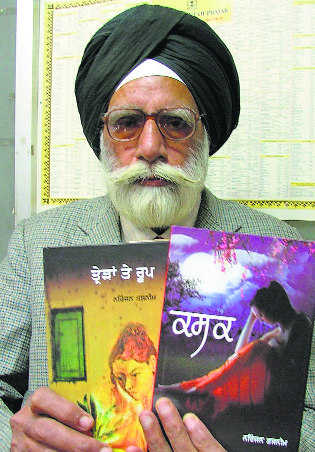
NS Tasneem, who passed away recently.
Tejwant Singh Gill
For novel writing in Punjabi, Niranjan Singh Tasneem was a master craftsman. Some days back, he died at the age of 90. His death is a big loss indeed. For many years, he taught this genre in several post-graduate colleges. His teaching did not stop at delivering lectures on the theory and textual study of novels prescribed in the syllabi. He extended his mastery to novel writing, first in Urdu and then in Punjabi. His Studies in Modern Punjabi Literature showed his devotion to the subject. Its Punjabi version was meant for the benefit of those deficient in English. He wrote a couple of novels in Urdu, and almost a dozen in Punjabi. Also, he translated some of them into English as well.
The craft he advocated for novel writing was a stream of consciousness, the style Virginia Woolf practised with consummate skill. The authority with which James Joyce employed it was too ponderous for his purpose. The novelist whom he rated the best in Punjabi was Nanak Singh. He was a master storyteller. Consistency was what he observed in living, thinking and feeling. Change was there but it came gradually.
In his Gwache Arthan (The Lost Meanings) that earned him the well-deserved award from the Sahitya Akademi, he sought to evoke the horror of 1984 by showing how a city had turned ghastly and ghostly due to reasons too horrible to recount. The technique he adopted accorded with his intention but between the intention and the execution, a lag was there. In its English version, which he himself was to prepare, the gap seemed very obvious. This was a dilemma Gurdial Singh also faced in Parsa, his last novel. He forged it into a work of metafiction. Tasneem’s above-mentioned novel preceded Gurdial's by almost a decade. To reach the common end, they employed vastly different modes. While Gurdial Singh took recourse to monolithic description, Tasneem preferred interrupted dialogues and persistent monologues. Both were colleagues for several years. Whether they ever exchanged views about novel writing in general and their respective works in particular is doubtful.
It was in Urdu that Tasneem began writing as a novice first, and then an expert. It was very creditable of him to write in Punjabi thereafter. Ret Chal was his first attempt in his mother tongue — he later translated it into English as well. Published in the mid-1960s, it was a story of love, interspersed with hesitation, indecision and reconciliation. The novels written then overflowed with passion and persuasion. Tasneem's novel was different not only for evoking new emotions and feelings but also for employing a narrative technique in which monologue figured a lot. Dialogue, spoken in undertone rather than declaimed aloud, was its another endearing factor. In all, it was a novelty, maybe for overusing these devices. He justified the exercise by holding that novels by earlier novelists taught the readers to live happily after meeting with success and failure. His novel, he asserted, was meant to teach them to live wisely by reconciling with the dilemmas posed by life. Ironically enough, the wisdom he insisted upon was of the worldly sort, not the epic side of truth.
Ik Hore Nawan Saal (Another New Year) was significant for conveying the message of work as worship. It depicted the day-to-day life of a rickshaw-puller who earned his living through hard work. Rather than gloat over the past, repent over the present and mourn over the future, he was content and hoped for better things to happen. His pithy remarks, desperate shouts, lengthy exclamations were meant to prove that change for the better could not be withheld for long. Was it Tasneem’s way of converting into Punjabi idiom the interminable technique James Joyce had employed in his masterpiece? If so, if not futile, it was too fragile an attempt to claim any merit.
During his long career, Tasneem wrote a lot, initially in Urdu and later in Punjabi. At the same time, he translated his works into English. It will be pertinent to know what significance he attached to the act of translation. Did he regard it only as conversion of which literalism was an essential factor or viewed it as a re-creation that implies several things with regard to diction, tone and rhythm? Rather than hasten with a reply, I choose to ponder over the issue.
— The writer is a noted academician



























